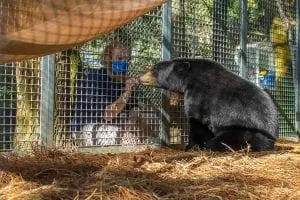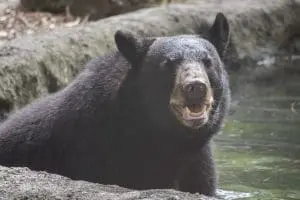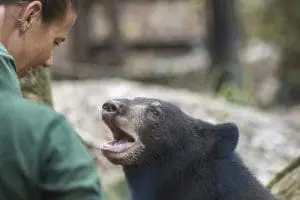

It’s always playtime when our two Florida black bears, Betty and Brody, meet up!
Our Zoo “answers the call” for native Florida species like sea turtles, Florida grasshopper sparrows, Perdido Key beach mice and more. When the number of human-bear conflicts began to rise over the years, we knew our Zoo should become a home for bears who couldn’t be returned to their natural range.
We just never thought we’d be a home to three young bears in four years! Still, we’re committed to providing our three rescued Florida black bears, Cheyenne, Brody and Betty, with the care that meets their complex physical, mental and social needs.
This November 29 on Giving ZOOday, we are raising money to help continue this level of care for our bears – and we hope to count on you for support!
Our Bears
Our bears’ stories are as unique as their temperaments, habits and relationships with each other and their animal care team!
 Five-year-old female bear Cheyenne was the first to arrive after she became accustomed to being fed food – in this case, dog food – from people. Our animal care team was expecting the then 20-month-old to be shy and upset at being removed from her natural habitat – instead they found her to be relaxed, interested in people, and willing to learn basic training cues. All indications that she had lost her fear of people.
Five-year-old female bear Cheyenne was the first to arrive after she became accustomed to being fed food – in this case, dog food – from people. Our animal care team was expecting the then 20-month-old to be shy and upset at being removed from her natural habitat – instead they found her to be relaxed, interested in people, and willing to learn basic training cues. All indications that she had lost her fear of people.
Cheyenne has kept that calm temperament with her keepers – and willingness to learn. She’s described as “always thinking” for a reason! She carefully figures out any new enrichment item put before her. As an adult female bear, she doesn’t always want to share space with our other bears, but thankfully, there’s space for everyone – in addition to the main habitat visible to you, there are several other habitats in behind-the-scenes areas.
 About a year after Cheyenne began living in her Zoo habitat, our animal care team received another call about a bear who couldn’t be released back into their natural range – but this time, a month-old bear cub joined our Zoo. Ears down, eyes shut, Brody had been found without his mother, likely abandoned because of his difficulties nursing and health issues. Our director of animal programs, Lauren Hinson, became his mom, bottle feeding him every few hours, keeping him close to her, and more. She and the rest of our team saw him through the abovementioned health issues, from pneumonia as a cub to issues with his hips.
About a year after Cheyenne began living in her Zoo habitat, our animal care team received another call about a bear who couldn’t be released back into their natural range – but this time, a month-old bear cub joined our Zoo. Ears down, eyes shut, Brody had been found without his mother, likely abandoned because of his difficulties nursing and health issues. Our director of animal programs, Lauren Hinson, became his mom, bottle feeding him every few hours, keeping him close to her, and more. She and the rest of our team saw him through the abovementioned health issues, from pneumonia as a cub to issues with his hips.
Brody today is a healthy, goofy 2-year-old male bear. At 270 pounds, he’s the largest of our bears – and he still has more growing to do! Brody tends to use his strength to figure out more difficult enrichment items, and this bear loves to wield a stick with jedi-like movements. While Brody rarely shares space with Cheyenne, he’s started enjoying playdates with our newest bear, Betty!
 Just this spring, we welcomed 9-month-old Betty to our Zoo – although not on a permanent basis at first. In April, we received a similar call to Brody – a female bear cub had been found without her mother. Lauren again became a bear mom for a few months, but instead of making her a Zoo resident, efforts were made to rehabilitate her to return to the wild. Unfortunately, Betty became too accustomed to people, and she was not able to be released. She returned to our Zoo instead.
Just this spring, we welcomed 9-month-old Betty to our Zoo – although not on a permanent basis at first. In April, we received a similar call to Brody – a female bear cub had been found without her mother. Lauren again became a bear mom for a few months, but instead of making her a Zoo resident, efforts were made to rehabilitate her to return to the wild. Unfortunately, Betty became too accustomed to people, and she was not able to be released. She returned to our Zoo instead.
Betty is a confident cub with very little fear! She loves to swim, and now, play with Brody. Her animal care team spent the first few months of her time with us playing with her in her habitat as bear siblings would do – but at 70 pounds, Betty is quickly becoming too big for playing with people. We’ll see what Betty is like as she gets older!
Bear Care
The habitats, enrichment and care for our bears have evolved as we’ve observed our bears over the years. Trees have become more accessible for climbing and perching. The enrichment items used to encourage their natural instinct to forage for their food have become more complex.
Our bears have even begun testing bear-resistant items. Their participation will help bears living in their native range by finding effective items for the public to use and hopefully lower the rate of negative interactions between people and bears.
After noticing how the seasons affect our bears, our animal care team started adjusting our bears’ enrichment opportunities according to the time of year. Enrichment can be anything that encourages an animal resident’s natural behaviors. For our bears, this often means giving them the opportunity to forage for their food in different ways, from shaking it out of a wobble tree to digging it out of a special feeder ball.
In the fall, we’ve noticed that Brody and Cheyenne are motivated but want easy food to bulk up for winter – so enrichments are less complex. During the winter, the bears are more sluggish and not as interested in food, while in the spring they have the motivation to work through more complex enrichments.
Taking note that Cheyenne was interested in building a den during the winter months, we went on to build dens in the bear’s public habitat as well as their private space. Last winter, Cheyenne used one of the dens regularly – even spending weeks sleeping inside.
Next time you peek into our bear habitat, see how many enrichment items you can spot! Feeder balls, hanging faux logs, snacks tucked into trees, a device that sprays seeds or nuts into the habitat – all are prime bear fun!
Giving ZOOday
We’re dedicated to providing our bears with the best life possible. We’re so happy to have been a safe place for our now adult bears, Cheyenne and Brody, to grow up in. It’s wonderful to get to watch Betty do the same!
With your help, we want to provide new and innovative opportunities for our trio – and any bears that may call us home in the future – to thrive in our care. We need $25,000 to cover the cost of diets, enrichment and more for Cheyenne, Brody and Betty – any donation will help us toward this goal!
While Giving ZOOday will take place on November 29, you can help us reach our goal at any time by donating; sharing our posts on Facebook, Twitter and Instagram; or creating a Facebook fundraiser!
Thank you for your support. You make it possible for us to make a difference by answering the call to help native species – and providing our animal residents with comfortable, healthy lives.